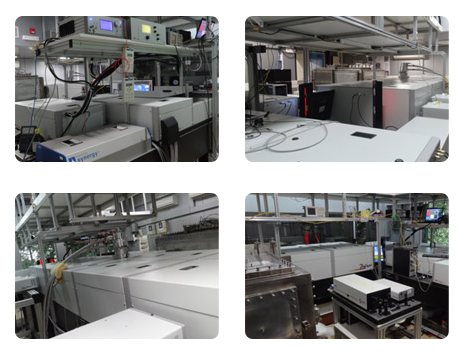UPHILL
Ultrashort Pulse High Intensity Laser Laboratory
Operational
We work at the frontier of laser-matter interactions by exciting matter with intense, femtosecond laser pulses of peak powers of 20-100 Terawatt. The major physics interest in this area arises from the fact that we can create extremely hot plasmas that are simultaneously ultra-dense and highly excited state of matter not easily accessed otherwise. For instance, it is possible to create plasmas with temperatures of a few keV which have free electron densities of the order of 1024/cm3. In addition, these plasmas contain hot electrons that are extremely energetic, going all the way upto millions of electron volt. These hot electrons can propagate out of the plasma like a highly directional beam or they can transfer their energy to the ions leading to energetic ion generation. They can also lose their energy by way of hard x-ray radiation. The interesting aspect of all these emissions is that they are of femtosecond duration, thus leading to a variety of ultrafast radiation sources. These hot electrons are also responsible for generation of the largest magnetic fields known on earth – nearly a billion gauss.

Tata Institute of Fundamental Research
http://www.tifr.res.in/SCIENTIFIC DOMAINS
High Intensity Physics
Key words: Giant Magnetic Fields, Ion acceleration, Neutral-Atom Accelerators, Bright, Hard X-ray Sources, Laser-Plasma Dynamics
FACILITIES
20 TW 30 fs Ti:Sa LASER (2006 ONWARDS)
100 TW 25 fs Ti:Sa LASER (2012)

SERVICES
Pulsewidth measurement and optimization are obtained using a variety of diagnostics, namely FROG, SPIDER and SEQUOIA. In addition, there is a time-delayed probe line for each of the lasers for routine pump-probe experiments in different configurations. Other typical diagnostics used on a regular basis are electron spectrometers, charge-coupled devices (CCDs) in the visible as well in the infra-red (IR) regimes, x-ray CCDs, intensified charge-coupled device cameras (ICCDs), semiconductor and scintillation detectors, single-shot optical spectrometers, Thomson parabola ion spectrometers and time-of-flight mass spectrometers.
EVENTS
Check the following events: